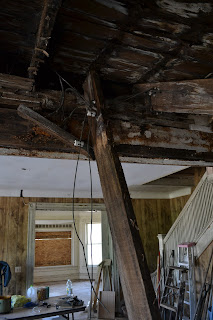Much of my first week has been spent in meetings…with
locals, with police enforcement, with artists, local business owners,
politicians, activists, and committees. This project is much more prevalent on
the radar than the house in Buffalo. As a result – and in the interest of
exploring a method which can proliferate – I’ve been at work trying to find
more legitimate ways of accessing waste material apart from the vigilante ways of
the past. Mostly, I’m met with great deal of respect and enthusiasm…and then a
“but it’s just too much of a liability concern.”
Especially in an economically strained city like Flint,
every demolition is a missed opportunity. I was able to speak to Mayor Walling
extensively about this yesterday morning. He wholeheartedly agreed and was able
to put me in touch with the local Habitat for Humanity group. During my time
working with Habitat in Buffalo, I noticed even they discard a lot of still
usable material when doing renovations (most of their work is renovation,
rather than new-build). Typically the majority of the house is gutted, leaving
an excess of true 2x4’s (many of which were slow-grown to much higher qualities
than today’s rapidly sprouted pine), insulation, and other materials. From my
conversation with Habitat Flint it seems likely I’ll have almost free reign
over materials in at least two properties they’ll be renovating in the near
future.
I also have some new friends with contacts in the demo
business for more pre-emptive scavenging, and have been in touch with several
commercial roofing companies who throw away a lot of useful and still healthy
rubber material which may be able to be repurposed for the roof at Spencer’s.
Later I met with the Carriage Town Historic Neighborhood Association
- who currently holds rights to Spencer’s - to pitch the project and officially
pass the 3-year lease with the Flint Public Art Project. Mostly the project was
well-received – even deemed “a godsend.” The discussion got slightly heated
though, when I was asked what my plans were regarding historic preservation of
the building – that is, maintaining an exterior aesthetic consistent to some unspecified
date in the distant past. I initially shrugged it off, failing to see why that
mattered to a house which currently has a roof that is caving in, boards still
over most of the windows, in a neighborhood crawling with fiends and criminal activity
(and then an entire block of houses in the same condition following behind it).
Apparently, the Historic District Commission is stringent on the cosmetics of
buildings in any historic district (Carriage Town being one of them), and would
rather let an entire block of houses rot or catch fire than let one put in his
choice of window. The CTHNA was disappointingly subdued when I suggested challenging
the HDC’s current requirements. With the dire situation that Flint is in,
especially Grand Traverse St., one would think the system more flexible. From
an architectural standpoint, the resonation of the old with new would be
exciting. From a communal standpoint, it would define from the outside a
rebirth of the building and a revitalized effort for creative thinking and
resourcefulness: hope. I hope to be able to arrange some negotiations with the
HDC, or the history they’re trying so hard to protect won’t just be the wrong
color; it’ll be gone entirely.





















